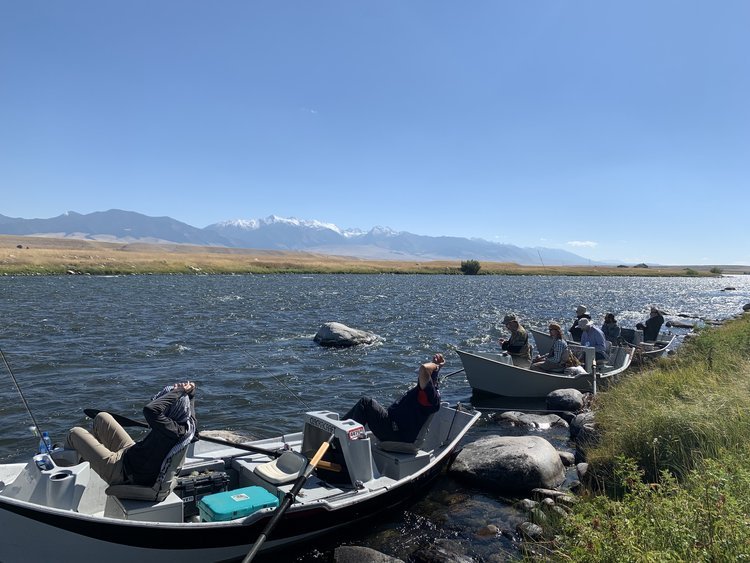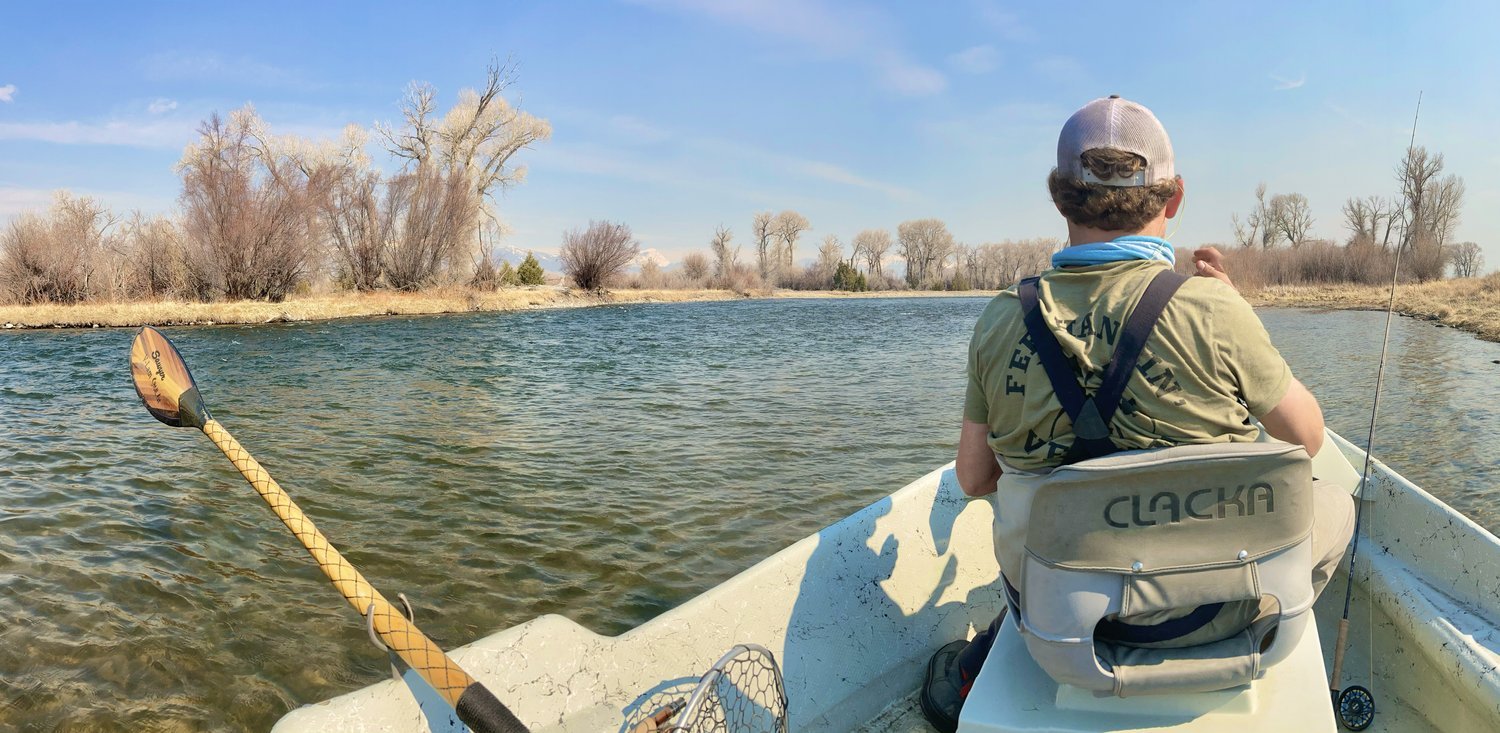Sections of the Madison River
“In many ways the Madison feels like a completely different river from one location to the next. The variety along this legendary fishery is one of the many factors that makes it one of the most consistent rivers in Montana.” -
The Madison River in Montana is a fly fisherman's dream. With its pristine waters and abundant trout populations, this river offers fly anglers of all levels a chance at big rainbows and monster browns. The Madison, however, isn't a single stretch of river that can be fished the same way 365. Instead, looking at the river as smaller sections with unique ecosystems and the best times of the year is easier. In this article, we dive into the sections of the Madison River and discuss the best times of year to target trout in each of them.
Yellowstone National Park to Hebgen Lake
BIG Brown Trout on the Madison
Trip Offered by: Fishtales Outfitting
The Madison starts inside the boundaries of Yellowstone National Park, where the park's hot springs and geysers aid part of the river's feeder streams. While this warmer water isn't ideal for summer trout fishing, spring and fall fishing can be fantastic due to the warmer water conditions inside the park. Many trophy browns are netted during October as fish from further down the river make their way up towards the park. Yellowstone does not permit rafting on this section, so the uppermost Madison is Wade only.
After departing Yellowstone, the Madison drifts to Hebgen Lake, a manmade lake created by the Hebgen Dam; these calmer waters hold a healthy population of brown trout that use the upper Madison to spawn. Hebgen is a sizable body of water, and floating is the preferred method of flyfishing here.
Hebgen Dam to Quake Lake
Trip Offered by: Atlas Flagg
Less than three miles below Hebgen Dam, the river runs into another dam, this time naturally made, at Quake Lake. Quake Lake was created in August of 1959 as the result of a 7.1 magnitude earthquake. The quake rock slide blocked the Madison River at the westward end of Madison Canyon. Like damming a stream as a child, the rockslide created an upstream lake. The area around this rockslide has since been preserved as the Madison River Canyon Earthquake Area. The tailwater flowing out of Hebgen dam is released from the bottom of the lake, producing cold water throughout the year. This makes the summer season reliable for trout fishing, unlike many other stretches. The short section between the two lakes is popular with anglers and does receive a fair amount of fair-weather fishing pressure.
Quake Lake to Reynolds Bridge
Trip Offered by: Atlas Flagg
In the rocky, fast-moving area below Quake Lake, known as "The Slide," the river makes a sharp drop, creating fast water moving around fresh boulders resulting from the earthquake half a century prior. The Slide is a wade-only section with larger-than-average fish sitting in the relative safety of eddies in the river. Though fishable for most of the year, the lower late summer and fall are preferable, with reduced river levels compared to the spring.
Reynolds Bridge to Lyons Bridge
Trip Offered By: Atlas Flagg
The Madison River begins to widen and slow after it passes through Reynolds Bridge and becomes a reliable drifting river again. With few feeder streams, the Madison runs clear for most of the year, making sight fishing for trout much more manageable than some sediment-clogged stretches. The "Big Bend" section provides excellent riffles, side channels, and islands. The area between these two bridges is easily accessible for wading anglers willing to walk from the parking spots off the highway, so it does receive fishing pressure, but with high trout counts, the added competition is hardly felt.
Lyons Bridge to Varney Bridge
Trip Offered by: Atlas Flagg
The Madison River from Lyons Bridge begins to flatten and slow even further, making sight fishing a top option for both wader and driftboat anglers. The large boulders cause massive plunge pools or "buckets" that routinely hold fish and make easily identifiable targets when drifting. A word of advice: put down the rod and look up while drifting. The scenery on this stretch is as dynamic as it is beautiful. From the area of Storey Ditch, Madison, and the highway turn away from each other, giving anglers a sense of isolation not found on the rest of the river. The salmon fly hatch in late June creates ideal conditions to land sizeable brown and rainbow trout on this slow-rolling section of the river.
Varney Bridge to Ennis
The Madison, yet again, changes to a different type of river for this lower section. Deep undercut banks, gravel bars, and a channel split make this section an excellent option for combinations of floating and wading. Drifting to an attractive section and hopping out of the boat to target trout on their level is conducive to taking the large browns that are famous in the area. Fishing is best in this section when water levels are lowest, and the spooky trout will be easier to ambush. Float fishing is not permitted below the Highway 287 access site outside of Ennis so that the wading anglers can have the river to themselves.
Ennis to Ennis Lake
Trip Offered by: Fishtales Outfitting
The Madison, running through the town of Ennis, Montana, may have some of the largest brown trout in the entire river system. While the overall number of fish on this stretch of river is fewer, the prohibition on drift boat fishing and the large breeder fish that migrate up from Ennis Lake make the town and its winding channels draining into the lake ideal fishing grounds, especially in the fall as the browns move from the lake to the rivers.
Ennis Dam to Beartrap and the Lower Madison
Below Ennis Lake and Dam is a section of whitewater known as Bear Trap Canyon. Hemmed in on either side by mountains, the Madison picks up speed and becomes a noticeable stretch of rapids. Fishing is not recommended for anyone but the most well-versed in this section, and as such, the fishing pressure is very low. Fishing this section relies on the snowmelts from further up the river; before and after the snow melts, early spring and late fall are often the best times to fish the beartrap section.
Below Beartrap, the river is known as the Lower Madison. The Lower Madison is a slow-rolling trout river that makes for excellent rainbow and brown fishing. The summer temperatures on the lower river are often too warm for decent daytime fishing. Early spring and late fall are the preferred times for anglers fishing in this section.
The Madison river is an incredible and dynamic trout river from National Park to the Lower River. Fly fishermen looking for rainbows and browns can find sections of the river to fish during any hatch and any season after a quick chat with a guide or fly shop. For anglers looking to take the guesswork out of finding a reliable guide and sorting through "fly shop talk," GuideBook is here to put anglers and guides in contact so they can put lines in the water and trout in landing nets.









